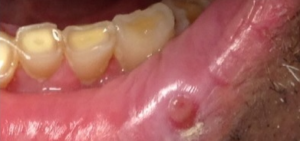✓ Cold Sores

– Cold Sores –
- Often called fever blisters, usually occur on the lips or around the mouth. Caused by the herpes simplex virus, or HSV, and transmitted through skin contact with an infected person, this infection spreads easily. Cold sores generally follow the same stages: tingling, blistering, weeping, crusting and healing.
Stage 1 – Tingling
The first stage of cold sore development usually presents as a burning, tingling or itching sensation around the lips or nose. The tingling stage, also called the prodromal stage, lasts for one to two days. The tingling spot may swell, turn red or feel sore. The tingling stage is the best time to treat a cold sore. No cure exists, but pain management remedies do work as treatment. Treatment options include physician-prescribed antiviral medications, over-the-counter creams and ointments and icing to numb the affected area.
Stage 2 – Blistering
Within 12 hours of the tingling stage of a cold sore, the blistering stage occurs, bringing with it a small, red area with fluid-filled blisters. One blister may appear, but the possibility exists of several blisters developing. The duration of the blistering stage is usually two days.
Stage 3 – Weeping
Following the blistering stage comes the one day long weeping stage, also called the ulcer stage. As sores that developed during the blistering stage grow, they rupture and leak fluid containing infectious viruses, making this a highly contagious stage. The red sores may become gray at this point. The weeping stage is often the most painful.
| | | Next → | Single Page